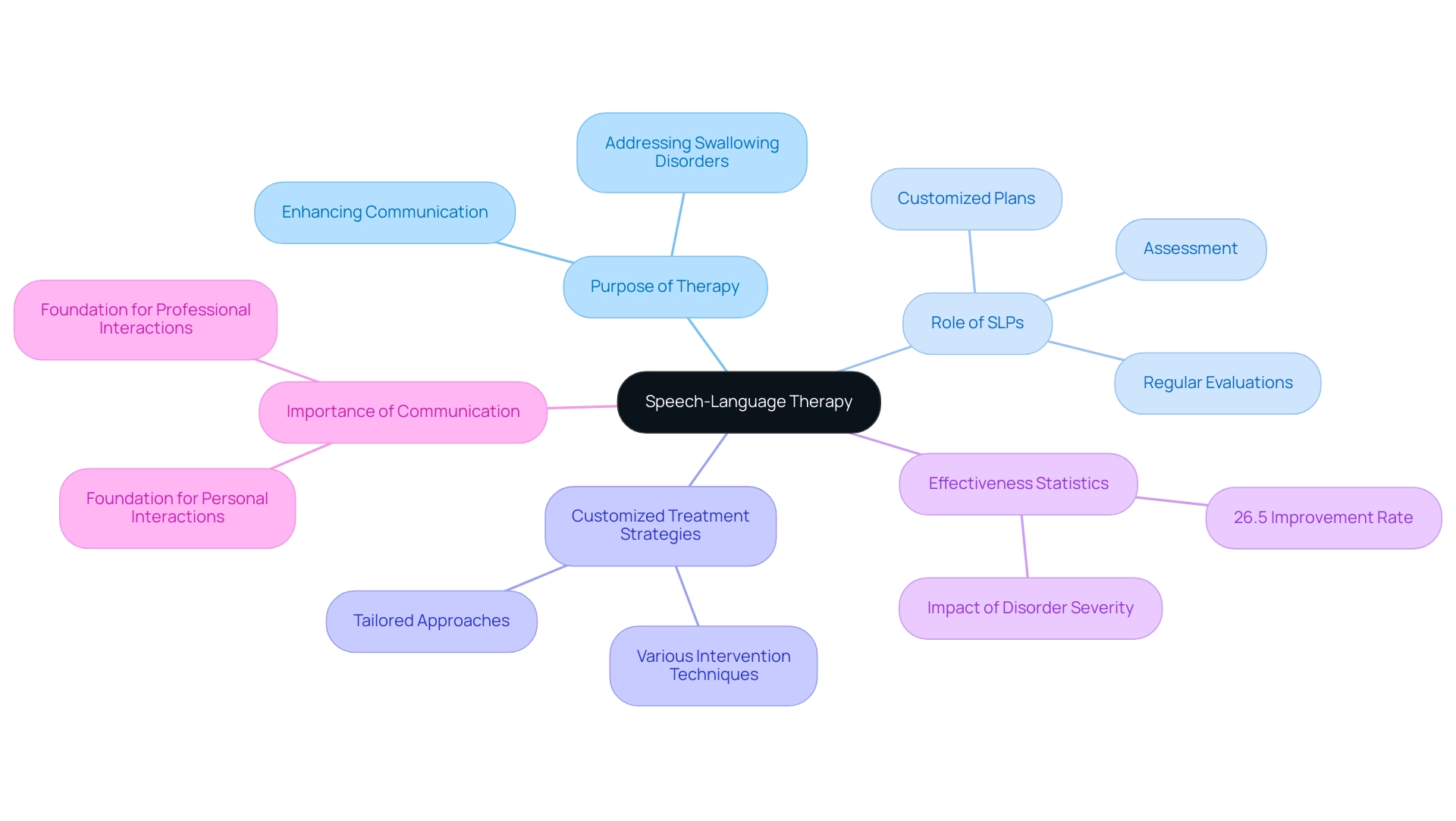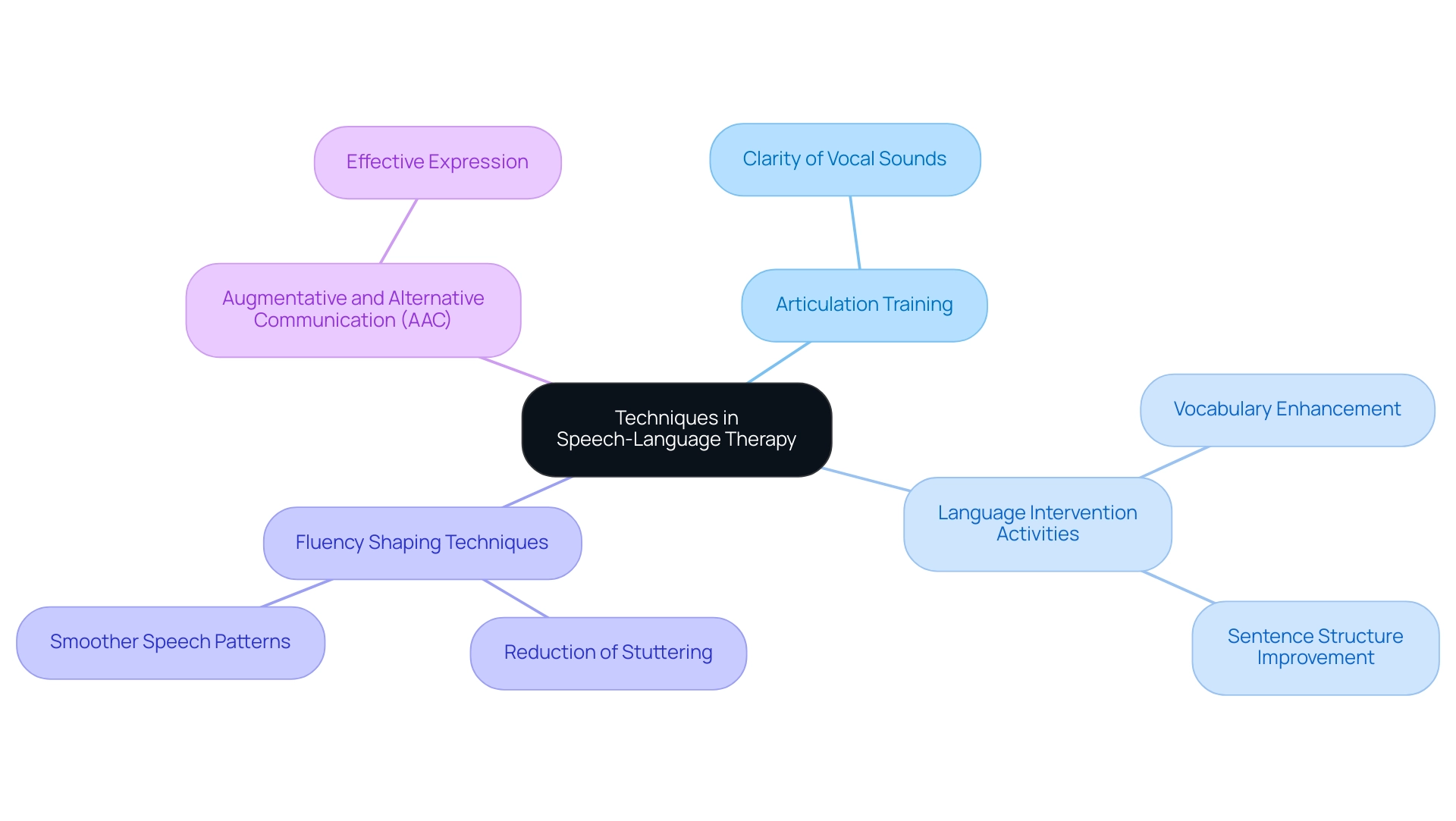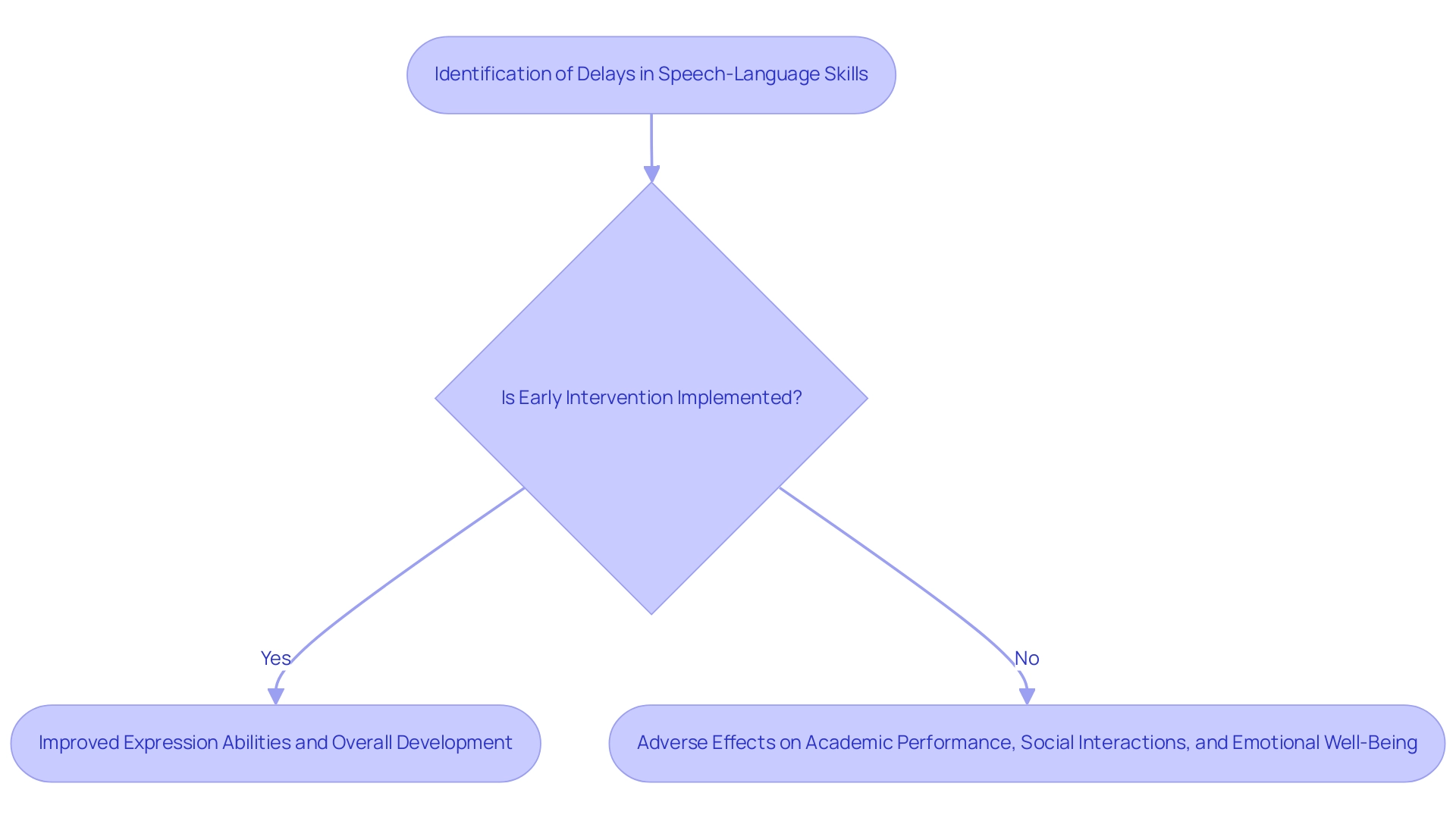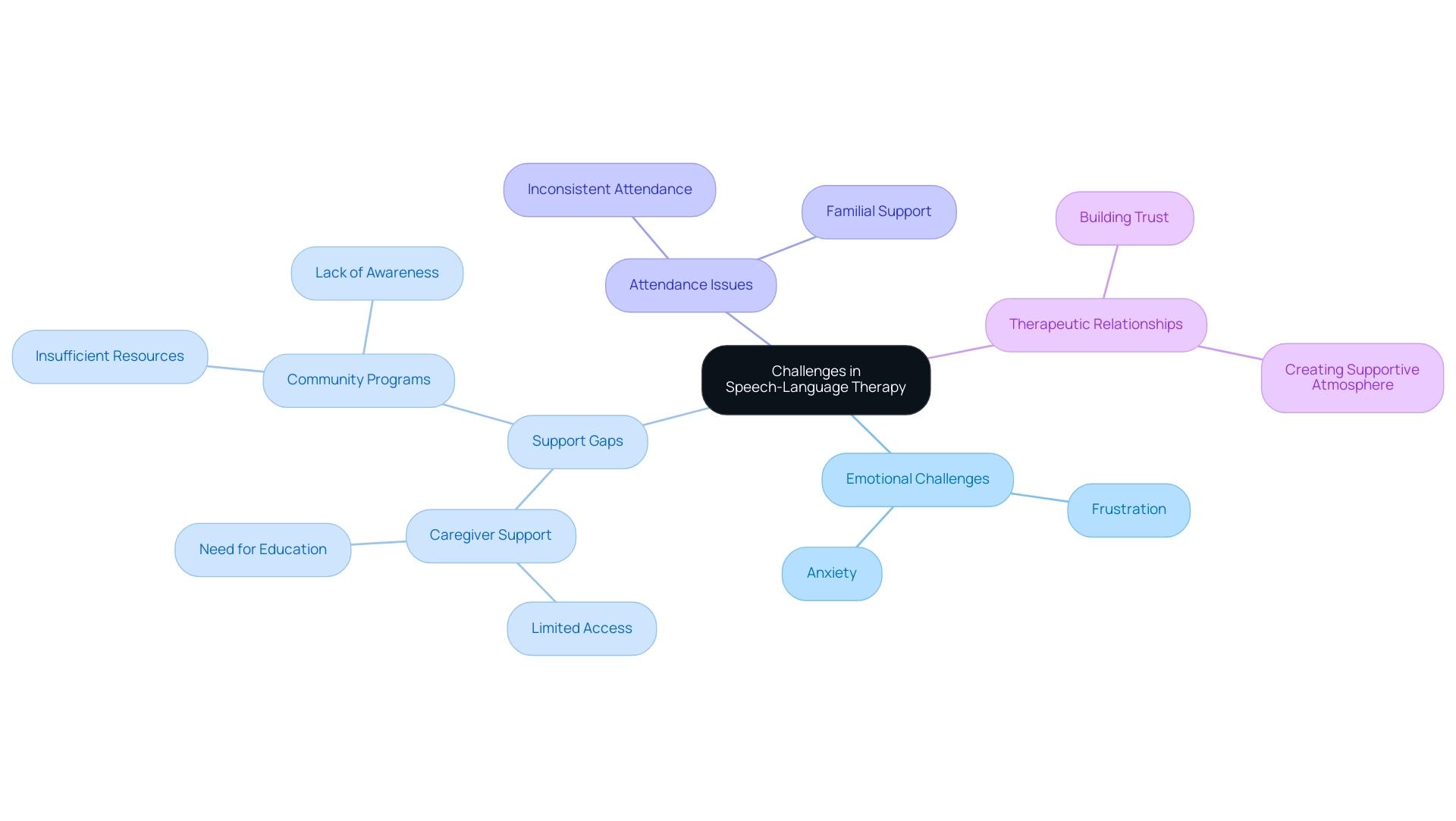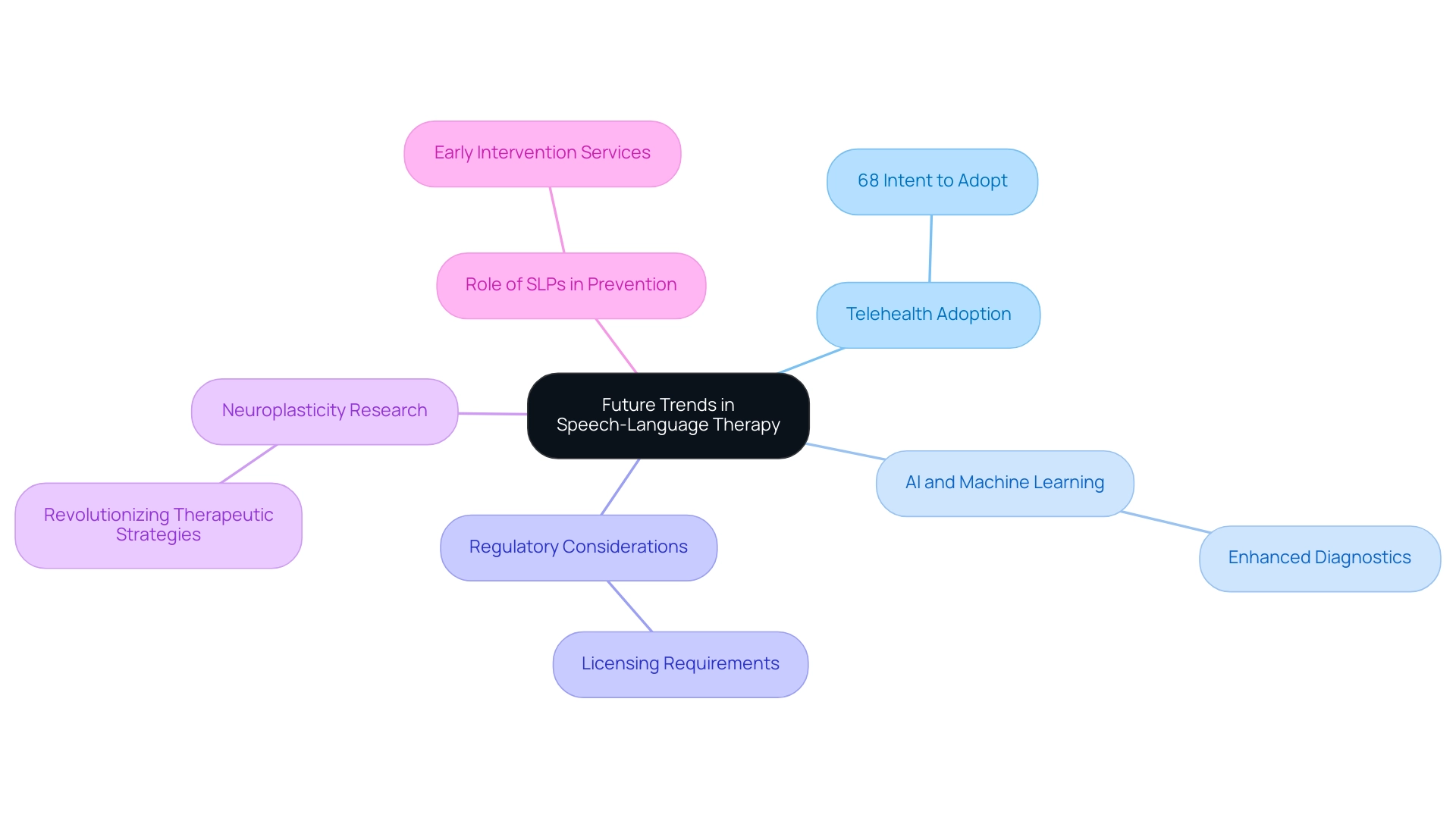Introduction
In the realm of communication and swallowing disorders, speech-language therapy stands as a crucial intervention that impacts individuals across all ages. This specialized field not only addresses the complexities of speech, language, voice, and fluency but also plays a significant role in enhancing the quality of life for those affected.
With nearly 180,000 Americans acquiring aphasia annually, the demand for skilled speech-language pathologists (SLPs) has never been greater. By employing tailored treatment strategies and evidence-based techniques, SLPs work diligently to foster improved communication skills, thereby empowering clients to navigate their personal and professional lives with confidence.
This article delves into the essential components of speech-language therapy, exploring its techniques, the importance of early intervention, the challenges faced, and the future trends shaping this vital field.
1. Defining Speech-Language Therapy: An Overview
Speech language therapy is a specialized discipline dedicated to the assessment and treatment of communication and swallowing disorders. This field encompasses a variety of practices aimed at enhancing speech, language, voice, and fluency, making speech language therapy vital for individuals across all age groups. Each year, nearly 180,000 Americans acquire aphasia, with approximately 2 million currently living with the condition.
Speech-language pathologists (SLPs) are extensively trained professionals who evaluate the unique needs of their clients, developing customized intervention strategies within the framework of speech language therapy that address specific disorders. For example, SLPs develop customized treatment strategies based on personal objectives and difficulties, utilizing various intervention techniques and modifying these plans through regular evaluations. Such tailored approaches significantly optimize treatment effectiveness, with evidence showing that 26.5% of individuals experience improvement across multiple domains.
The effectiveness of communication intervention is further emphasized by the understanding that the
severity of a language disorder directly influences the duration and success of treatment; more severe conditions often require extended care for substantial improvements. As emphasized by Great Speech, "We provide an extensive network of speech and language pathologists eager to connect with you and assist you in achieving better interaction and enhanced confidence." Consequently, understanding the importance of speech language therapy is essential, as effective communication is foundational to both personal and professional interactions.
2. Techniques and Approaches in Speech-Language Therapy
The techniques and approaches used in speech language therapy encompass a diverse array specifically designed to meet the unique needs of each client, particularly those affected by conditions like
spasmodic dysphonia. Among the most prevalent techniques is articulation training, which concentrates on improving the clarity of vocal sounds. Language intervention activities are similarly vital in speech language therapy, as they aim to bolster vocabulary and enhance sentence structure.
Furthermore, fluency shaping techniques are employed to help individuals reduce stuttering and achieve smoother speech patterns. According to recent studies, these techniques have shown a significant effectiveness rate, with speech language therapy improving clarity in over 75% of cases. For individuals with more severe speech difficulties, speech-language pathologists (SLPs) may incorporate augmentative and alternative communication (AAC) devices, which enable effective expression.
A case study emphasized the significance of speech language therapy, demonstrating that personalized treatment plans resulted in enhanced verbal skills and greater confidence in social interactions for children with language disorders. The selection of techniques is predicated on a comprehensive assessment of the client's specific challenges, ensuring that the chosen approach is the most effective. This tailored approach is essential not only for fostering improved interaction skills but also for significantly enhancing the quality of life for individuals grappling with speech language therapy needs.
3. The Importance of Early Intervention in Speech-Language Therapy
Prompt intervention in speech language therapy is essential for enhancing treatment results and promoting improved interaction abilities in children. Research indicates that 0.9% of U.S. children aged 3 to 17 experience swallowing disorders lasting a week or longer, underscoring the urgency for early assessment and intervention to prevent further complications. The
American Speech-Language-Hearing Association (ASHA), with its approximately 234,000 dedicated members, emphasizes their commitment to helping children overcome these challenges through various therapeutic approaches, including speech language therapy as part of both individual and group therapy.
Addressing speech and language issues in early childhood can lead to significant improvements in expression abilities and overall development. Conversely, delays in intervention can result in severe challenges later in life, adversely affecting academic performance, social interactions, and emotional well-being. For instance, a study on children with slow expressive language development revealed that those who received timely support exhibited comparable language skills to their peers, while those with lingering issues faced considerable impairments in language and literacy as adolescents.
Parents and caregivers are encouraged to seek evaluations in speech language therapy by speech-language pathologists at the first signs of delays in their children's ability to express themselves. By acting promptly, families can ensure that their children receive the necessary support to thrive.
4. Challenges Faced in Speech-Language Therapy
Speech-language treatment is often fraught with challenges for both clients and therapists. Many individuals encounter significant frustration or anxiety stemming from their communication difficulties, which can markedly hinder their progress. Alarmingly, reports indicate that only 11% of caregivers have access to additional supports in daycare and community programs, highlighting a
critical gap in assistance that can exacerbate these issues and hinder treatment outcomes.
Furthermore, inconsistent attendance at therapy sessions and insufficient familial support frequently hinder the effectiveness of treatment. Therapists are tasked with addressing a diverse array of needs, necessitating a flexible and creative therapeutic approach. Research emphasizes the significance of establishing a strong relationship with customers; nurturing a supportive atmosphere is crucial for sustaining motivation and engagement.
A notable case study titled 'Stigma and Family Readiness in Autism Diagnosis' illustrates how stigma can lead to caregiver denial and reluctance to seek necessary speech-language services. The findings suggest that by addressing these stigmas and enhancing family readiness through targeted education and support, engagement with speech-language services for autistic children can significantly improve. As highlighted by the US News and World Report, the role of Speech-Language Pathologists is increasingly recognized, ranking #10 on the list of 100 Best Jobs in 2024.
This recognition highlights the significance of tackling obstacles in speech-language treatment, ensuring fair service provision, and improving cooperation in support of individuals.
5. Future Trends in Speech-Language Therapy
The field of speech language therapy is undergoing a dynamic transformation, driven by technological advancements and ongoing research. As noted by Towey (2012), the upgrade of communication telepractice for the 21st century has made teletherapy a crucial tool, enabling therapists to connect with clients remotely. This is especially advantageous for individuals residing in underserved regions.
Recent findings indicate that:
- 68% of surveyed language therapists express intent to adopt telehealth services in the near future, reflecting a significant shift towards this mode of practice.
- The integration of artificial intelligence and machine learning into assessment tools is poised to enhance both diagnostic precision and the development of tailored treatment plans.
- For instance, SLPs are increasingly utilizing AI to refine speech assessments, leading to more personalized interventions.
It is essential to note that, as per
ASHA guidelines, tele practitioners must be licensed in both the state from which they provide services and the state where the individual is located at the time of service, highlighting important regulatory considerations.
Concurrently, research into neuroplasticity continues to unveil insights that could revolutionize therapeutic strategies, potentially enhancing recovery outcomes for individuals. Additionally, case studies, such as 'The Role of SLPs in Prevention,' demonstrate how SLPs provide early intervention services through screenings and assessments to identify children who may benefit from targeted support.
As the landscape of speech language therapy evolves, practitioners must embrace adaptability, continually updating their methodologies and remaining informed about the latest developments to effectively meet the diverse needs of their clients.
Conclusion
Speech-language therapy plays a vital role in addressing communication and swallowing disorders across all ages, significantly impacting the lives of those affected. With nearly 180,000 Americans acquiring aphasia each year, the expertise of speech-language pathologists (SLPs) is increasingly essential. Tailored treatment strategies and evidence-based techniques are fundamental to fostering improved communication skills, enabling individuals to regain confidence in both personal and professional spheres.
The techniques employed in speech-language therapy, ranging from articulation and fluency shaping to the use of augmentative and alternative communication devices, demonstrate a commitment to personalized care. Early intervention emerges as a crucial factor in achieving optimal outcomes, highlighting the importance of timely assessments and support for children experiencing communication delays. Despite the challenges faced, such as stigma and limited access to resources, the dedication of SLPs remains unwavering, ensuring that clients receive the necessary assistance to thrive.
Looking forward, the integration of technology, including teletherapy and artificial intelligence, is reshaping the landscape of speech-language therapy. These advancements promise to enhance diagnostic precision and treatment effectiveness, particularly for underserved populations. As the field continues to evolve, a proactive approach to embracing new methodologies will be essential for SLPs to meet the diverse needs of their clients effectively. Ultimately, the ongoing commitment to improving communication abilities through speech-language therapy is not only beneficial for individual clients but also enriches the fabric of society as a whole.
